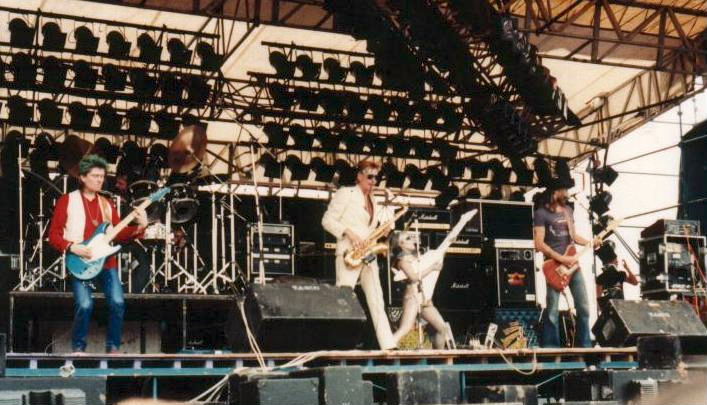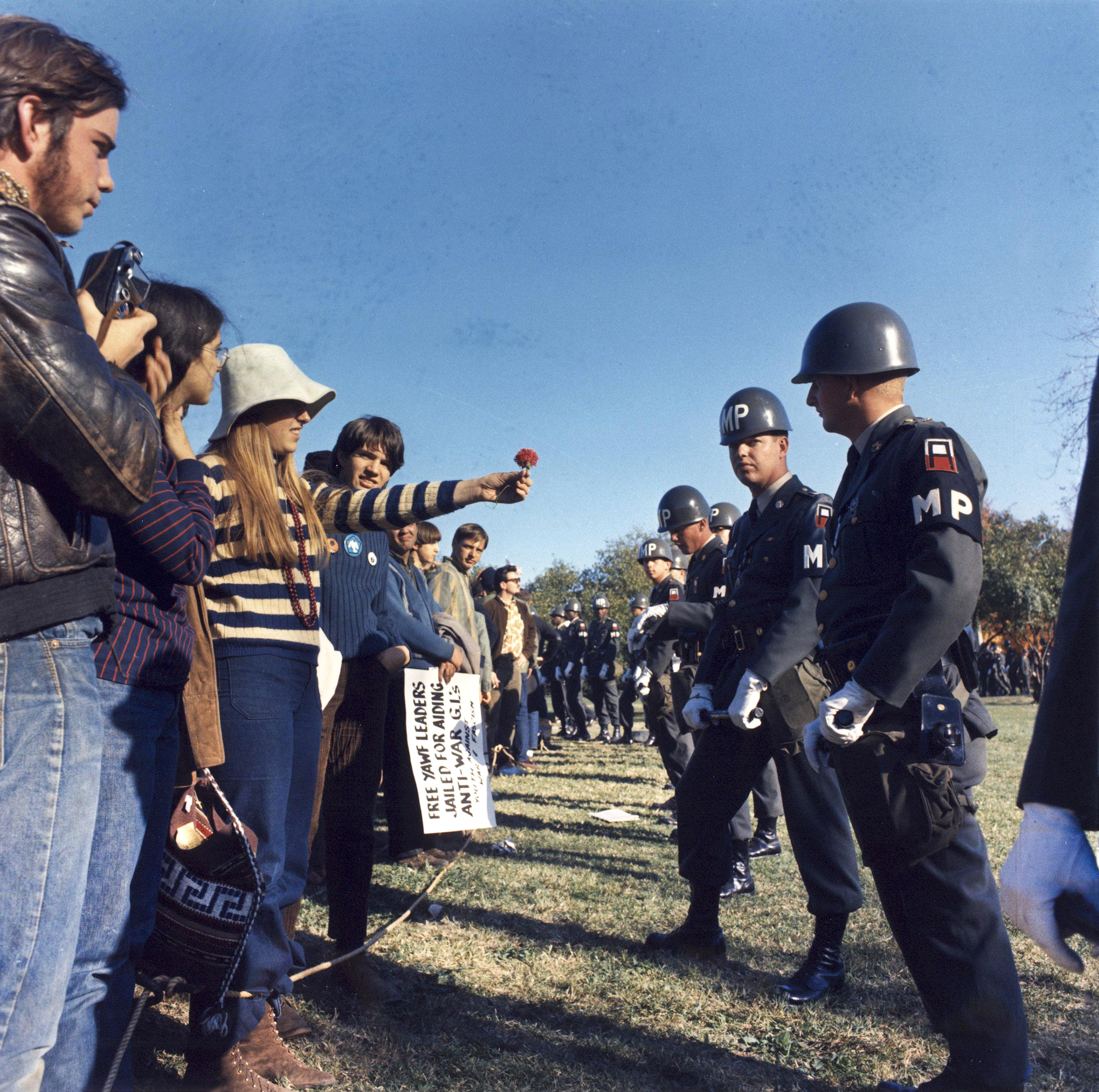|
Psychedelic Rock
Psychedelic rock is a rock music Music genre, genre that is inspired, influenced, or representative of psychedelia, psychedelic culture, which is centered on perception-altering hallucinogenic drugs. The music incorporated new electronic sound effects and recording techniques, extended instrumental solos, and improvisation. Many psychedelic groups differ in style, and the label is often applied spuriously. Originating in the mid-1960s among British and American musicians, the sound of psychedelic rock invokes three core effects of LSD: depersonalization, dechronicization, and dynamization, all of which detach the user from everyday reality. Musically, the effects may be represented via novelty studio tricks, electronic music, electronic or non-Western instrumentation, disjunctive song structures, and extended instrumental segments. Some of the earlier 1960s psychedelic rock musicians were based in contemporary folk music, folk, jazz, and the blues, while others showcased an expl ... [...More Info...] [...Related Items...] OR: [Wikipedia] [Google] [Baidu] |
Rock Music
Rock music is a broad genre of popular music that originated as "rock and roll" in the United States in the late 1940s and early 1950s, developing into a range of different styles in the mid-1960s and later, particularly in the United States and United Kingdom.W. E. Studwell and D. F. Lonergan, ''The Classic Rock and Roll Reader: Rock Music from its Beginnings to the mid-1970s'' (Abingdon: Routledge, 1999), p.xi It has its roots in 1940s and 1950s rock and roll, a style that drew directly from the blues and rhythm and blues genres of African-American music and from country music. Rock also drew strongly from a number of other genres such as electric blues and folk music, folk, and incorporated influences from jazz, classical, and other musical styles. For instrumentation, rock has centered on the electric guitar, usually as part of a rock group with electric bass guitar, drums, and one or more singers. Usually, rock is song-based music with a Time signature, time signature using ... [...More Info...] [...Related Items...] OR: [Wikipedia] [Google] [Baidu] |
Glam Rock
Glam rock is a style of rock music that developed in the United Kingdom in the early 1970s and was performed by musicians who wore outrageous costumes, makeup, and hairstyles, particularly platform shoes and glitter. Glam artists drew on diverse sources across music and throwaway pop culture, ranging from bubblegum pop and 1950s rock and roll to cabaret, science fiction, and complex art rock.P. Auslander, ''Performing Glam Rock: Gender and Theatricality in Popular Music'' (Ann Arbor, MI: University of Michigan Press, 2006), , pp. 57, 63, 87 and 141. The flamboyant clothing and visual styles of performers were often camp or androgynous, and have been described as playing with other gender roles. Glitter rock was a more extreme version of glam rock. The UK charts were inundated with glam rock acts from 1971 to 1975. The March 1971 appearance of T. Rex frontman Marc Bolan on the BBC's music show '' Top of the Pops'', wearing glitter and satins, is often cited as the beginn ... [...More Info...] [...Related Items...] OR: [Wikipedia] [Google] [Baidu] |
Anatolian Rock
Anatolian rock ( tr, Anadolu rock), or known as Turkish psychedelic rock, is a fusion of Turkish folk music and rock. It emerged during the mid-1960s, soon after rock groups became popular in Turkey. Most known members of this genre includes Turkish musicians such as Barış Manço, Cem Karaca, Erkin Koray, Selda Bağcan, Fikret Kızılok alongside bands such as Moğollar, Kurtalan Ekspres and 3 Hürel. History and development Background (1930s-1960s) Anatolian rock has a long history that dates back to the founding of the Turkish Republic decades ago. Modern Turkey's founding father, Atatürk, pushed extensive changes to build a national form of music from the early 1930s forward. Atatürk believed that the changes in music to be based on national and modern foundations and musicians should work on Turkish melodies and make them polyphonic according to the rules of Western harmonic music. As a result, Anatolian folk music began to spread and people began to listen Anat ... [...More Info...] [...Related Items...] OR: [Wikipedia] [Google] [Baidu] |
Zamrock
Zamrock is a musical genre that emerged and gained popularity in Zambia during the early 1970s.It has been described as a fusion of traditional African music and psychedelic rock, garage rock, hard rock, blues and funk, taking influence from popular bands like Black Sabbath, Blue Cheer, the Rolling Stones, Deep Purple, and Cream. Rock musician Rikki Ililonga and his band Musi-O-Tunya are widely regarded as the inventors of this style of music. Other notable artists include, but are not limited to, WITCH,WITCH on Dusted Magazine (15 April 2010) The Peace, Amanaz, Chrissy "Zebby" Tembo, and Paul Ngozi a ... [...More Info...] [...Related Items...] OR: [Wikipedia] [Google] [Baidu] |
Stoner Rock
Stoner rock, also known as stoner metal or stoner doom, is a rock music fusion genre that combines elements of doom metal with psychedelic rock and acid rock. The genre emerged during the early 1990s and was pioneered foremost by Kyuss and Sleep (band), Sleep. Characteristics Stoner rock is typically slow-to-mid tempo and features a heavily Distortion (music), distorted, Groove (music), groove-laden bass guitar, bass-heavy sound, melodic vocals, and "retro" production. Due to the similarities between stoner and sludge metal, there is often a crossover between the two genres. This hybrid has traits of both styles, but generally lacks stoner metal's laid back atmosphere and its usage of psychedelic music, psychedelia. Bands such as Weedeater (band), Weedeater, High on Fire and Electric Wizard creatively fuse both styles. Terminology The descriptor "stoner rock" may originate from the title of the 1997 Roadrunner Records compilation ''Burn One Up! Music for Stoners''. Desert rock ... [...More Info...] [...Related Items...] OR: [Wikipedia] [Google] [Baidu] |
Psychedelic Pop
Psychedelic pop (or acid pop) is pop music that contains musical characteristics associated with psychedelic music. Developing in the late 1960s, elements included "trippy" features such as fuzz guitars, tape manipulation, backwards recording, sitars, and Beach Boys-style harmonies, wedded to melodic songs with tight song structures. The style lasted into the early 1970s. It has seen revivals in subsequent decades by neo-psychedelic artists. Characteristics According to AllMusic, psychedelic pop was not too "freaky", but also not very " bubblegum" either. It appropriated the effects associated with straight psychedelic music, applying their innovations to concise pop songs. The music was occasionally confined to the studio, but there existed more organic exceptions whose psychedelia was bright and melodic. AllMusic adds: "What's trangeis that some psychedelic pop is more interesting than average psychedelia, since it had weird, occasionally awkward blends of psychedelia an ... [...More Info...] [...Related Items...] OR: [Wikipedia] [Google] [Baidu] |
Psychedelic Funk
Psychedelic funk (also called P-funk or funkadelia, and sometimes conflated with psychedelic soul) is a music genre that combines funk music with elements of psychedelic rock. It was pioneered in the late 1960s and early 1970s by American acts like Sly and the Family Stone, Jimi Hendrix, and the Parliament-Funkadelic collective. It would influence subsequent styles including '70s jazz fusion and the '90s West Coast hip hop style G-funk. History Origins: Late 1960s Inspired by Jimi Hendrix and the culture of psychedelia, black funk group Sly and the Family Stone borrowed techniques from psychedelic rock music, including wah pedals, fuzz boxes, echo chambers, and vocal distorters, on albums such as '' Dance to the Music'' (1968) and '' Stand'' (1969). The sound would also be reflected in the late 1960s output of iconic Detroit label Motown. Producer Norman Whitfield drew on this sound for popular Motown recordings such as The Temptations' "Cloud Nine" and Marvin Gaye's "I Hea ... [...More Info...] [...Related Items...] OR: [Wikipedia] [Google] [Baidu] |
Psychedelic Soul
Psychedelic soul (originally called black rock or conflated with psychedelic funk) is a music genre that emerged in the late 1960s and saw Black soul musicians embrace elements of psychedelic rock, including its production techniques, instrumentation, effects units (wah-wah pedal, phaser, etc.) and drug influences. It came to prominence in the late 1960s and continued into the 1970s, playing a major role in the development of funk and disco. Pioneering acts working in the genre included Sly and the Family Stone, Jimi Hendrix, Isaac Hayes, and the Temptations. Mainstream acts that developed a psychedelic sound included the Supremes, Stevie Wonder, the Chambers Brothers, the 5th Dimension, Edwin Starr, Rare Earth, Arthur Brown and George Clinton's Parliament-Funkadelic ensemble. History Origins Following the lead of Jimi Hendrix in psychedelic rock, in the late 1960s psychedelia began to have a widespread impact on Afro American musicians, particularly the stars of ... [...More Info...] [...Related Items...] OR: [Wikipedia] [Google] [Baidu] |
Space Rock
Space rock is a music genre characterized by loose and lengthy song structures centered on instrumental textures that typically produce a hypnotic, otherworldly sound. It may feature distorted and reverberation-laden guitars, minimal drumming, languid vocals, synthesizers and lyrical themes of outer space and science fiction. The genre emerged in late 1960s psychedelia and progressive rock bands such as Pink Floyd, Hawkwind, and Gong who explored a "cosmic" sound. Similar sounds were pursued in the early 1970s West German '' kosmische Musik'' ("cosmic music") scene. Later, the style was taken up in the mid-1980s by Spacemen 3, whose "drone-heavy" sound was avowedly inspired by and intended to accommodate drug use. By the 1990s, space rock developed into shoegazing, stoner rock and post-rock with bands such as the Verve, Flying Saucer Attack, and Orange Goblin. History Origins: 1950s-1960s Humanity's entry into outer space provided ample subject matter for rock and roll an ... [...More Info...] [...Related Items...] OR: [Wikipedia] [Google] [Baidu] |
Raga Rock
Raga rock is rock or pop music with a pronounced Indian influence, either in its construction, its timbre, or its use of Indian musical instruments, such as the sitar and tabla. In addition, rock music from the 1960s and 1970s that incorporates South Asian musical influences and instruments, along with Western ideas of the Indian subcontinent, is often regarded as raga rock. Since Indian influences in popular music are primarily limited to the 1960s, most raga rock recordings originate from that decade, although there are examples of Indian-derived sounds in post-1960s rock and pop music. Development Definition Ragas are specific melodic modes used in the classical music of the Indian subcontinent. The term "raga rock" originated in March 1966 as a description of rock music that featured Indian sitar styling. According to musicologist Jonathan Bellman, citing Lillian Roxon's 1969 book ''Rock Encyclopedia'': "This catchphrase eventually came to describe any Rock song that evok ... [...More Info...] [...Related Items...] OR: [Wikipedia] [Google] [Baidu] |
Acid Rock
Acid rock is a loosely defined type of rock music that evolved out of the mid-1960s garage punk movement and helped launch the psychedelic subculture. Named after lysergic acid diethylamide (LSD), the style is generally defined by heavy, distorted guitars, lyrics with drug references, and long improvised jams. Much of the style overlaps with 1960s garage punk, proto-metal, and early heavy, blues-based hard rock. The term is sometimes used interchangeably with "psychedelic rock", but it also specifically refers to a more musically intense subgenre or sibling of the psychedelic rock style. Compared to other psychedelic rock, acid rock features a harder, louder, heavier, or rawer sound. It developed mainly from the American West Coast, where groups did not focus on the novelty recording effects or whimsy of British psychedelia, and instead emphasized the heavier qualities associated with both the positive and negative extremes of the psychedelic experience. As the movement p ... [...More Info...] [...Related Items...] OR: [Wikipedia] [Google] [Baidu] |
Shoegazing
Shoegaze (originally called shoegazing and sometimes conflated with " dream pop") is a subgenre of indie and alternative rock characterized by its ethereal mixture of obscured vocals, guitar distortion and effects, feedback, and overwhelming volume.Pete Prown / Harvey P. Newquist: "One faction came to be known as dream-pop or "shoegazers" (for their habit of looking at the ground while playing the guitars on stage). They were musicians who played trancelike, ethereal music that was composed of numerous guitars playing heavy droning chords wrapped in echo effects and phase shifters.", Hal Leonard 1997, It emerged in Ireland and the United Kingdom in the late 1980s among neo-psychedelic groups who usually stood motionless during live performances in a detached, non-confrontational state. The name comes from the heavy use of effects pedals, as the performers were often looking down at their pedals during concerts. My Bloody Valentine's album ''Loveless'' (1991) is often seen as t ... [...More Info...] [...Related Items...] OR: [Wikipedia] [Google] [Baidu] |








